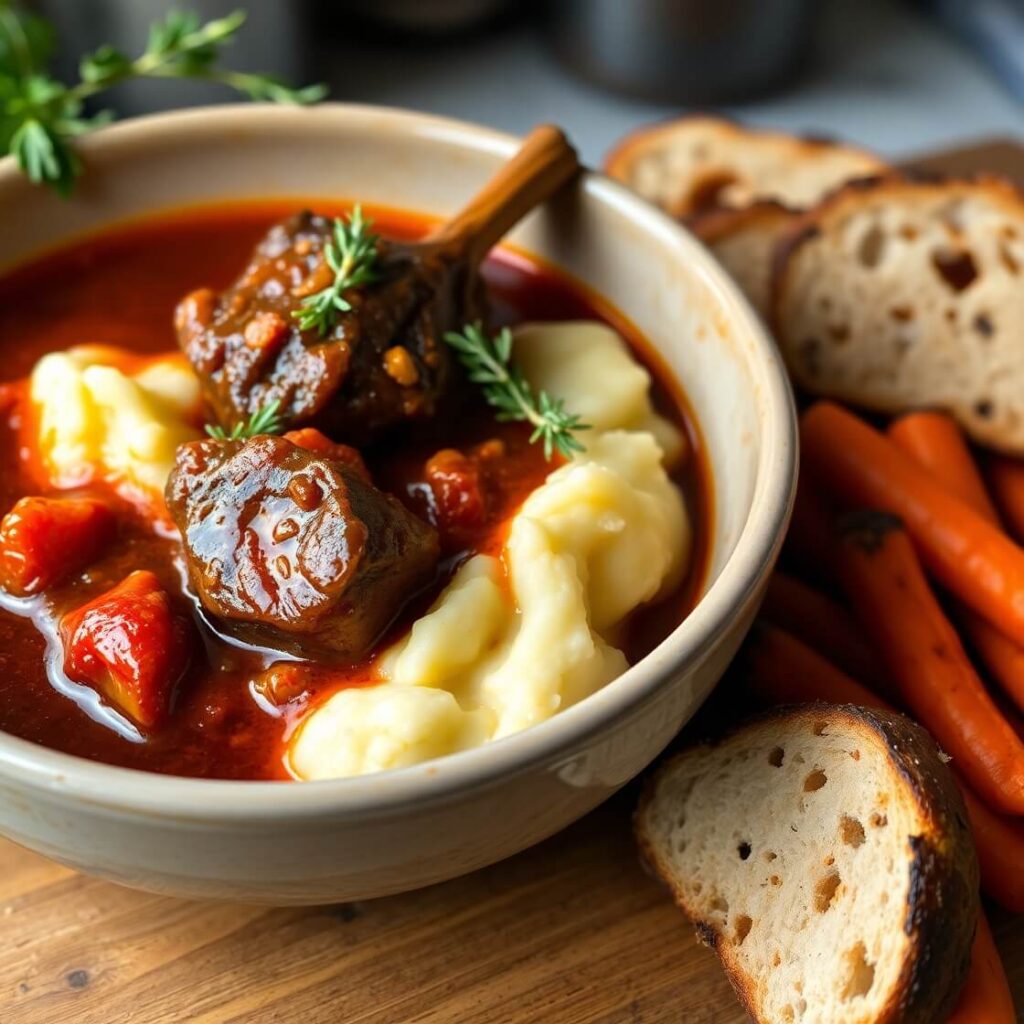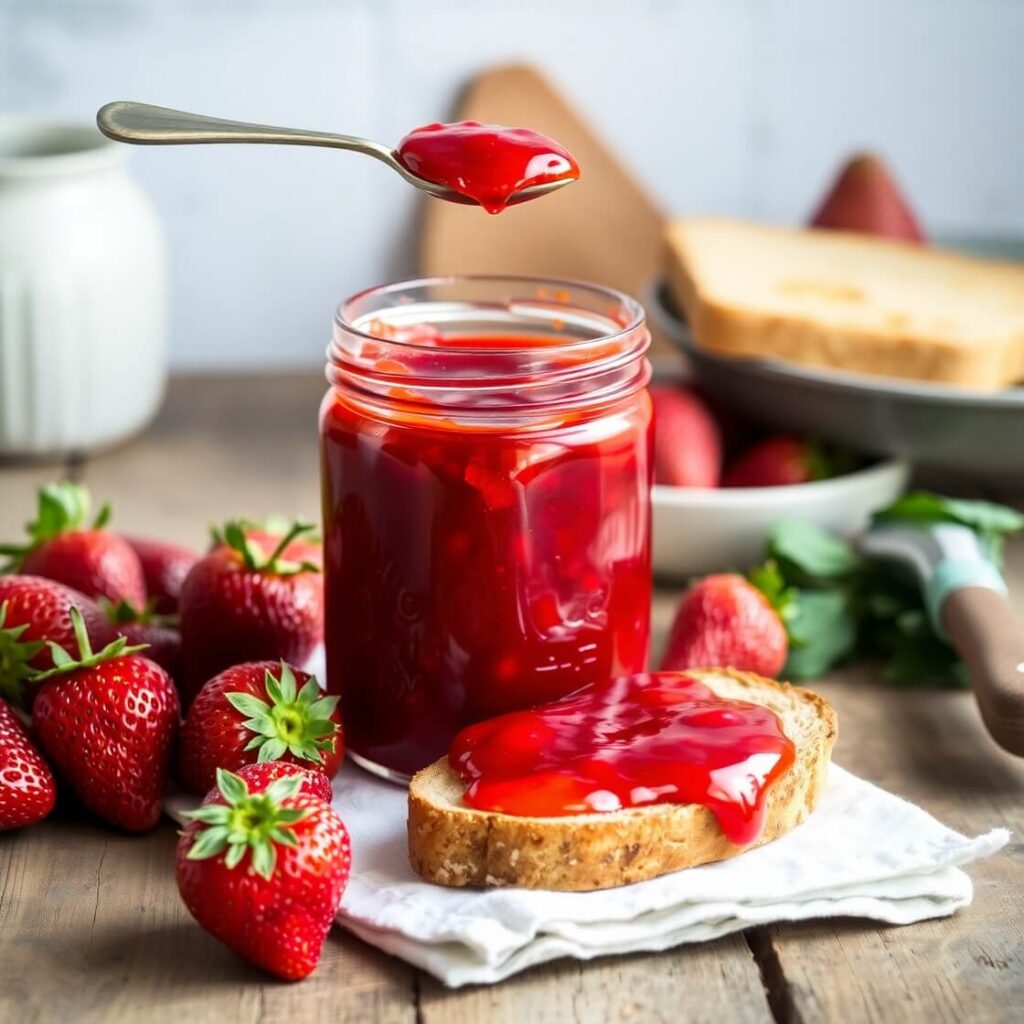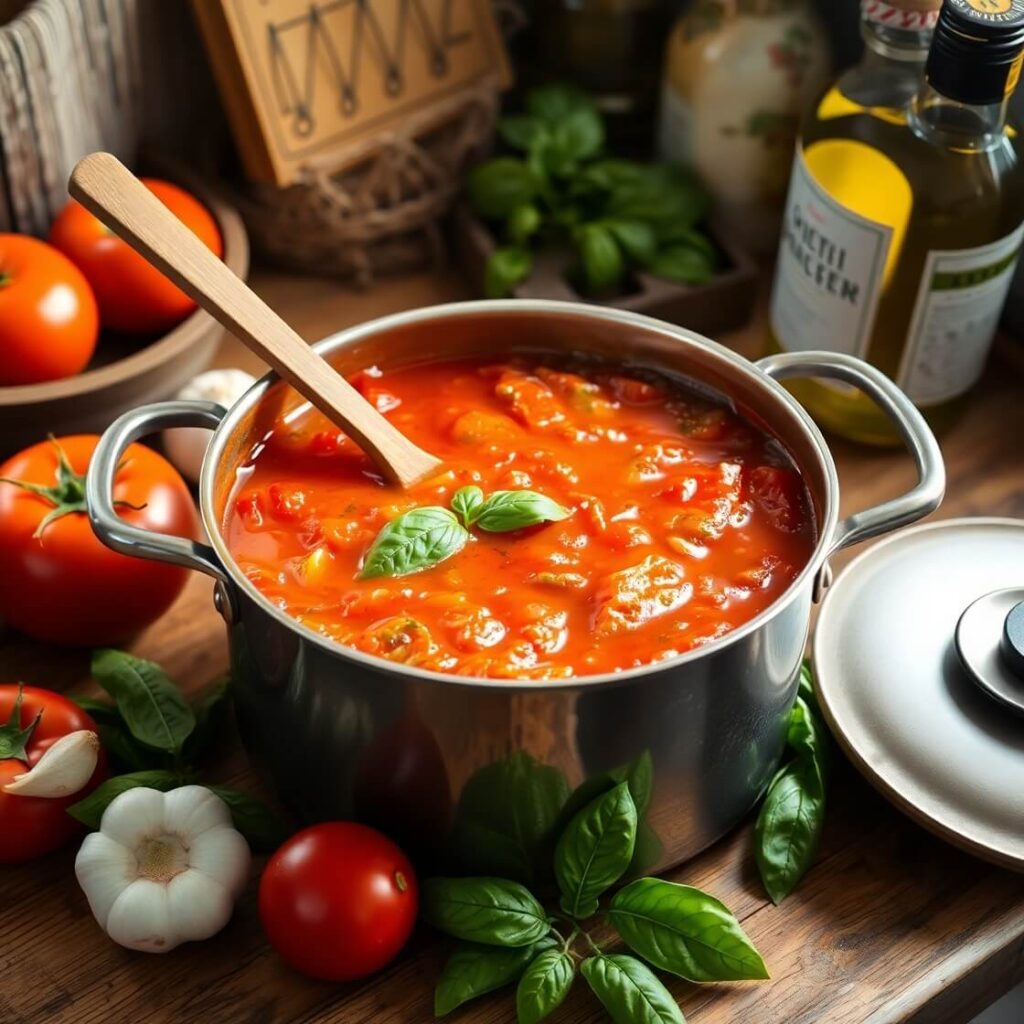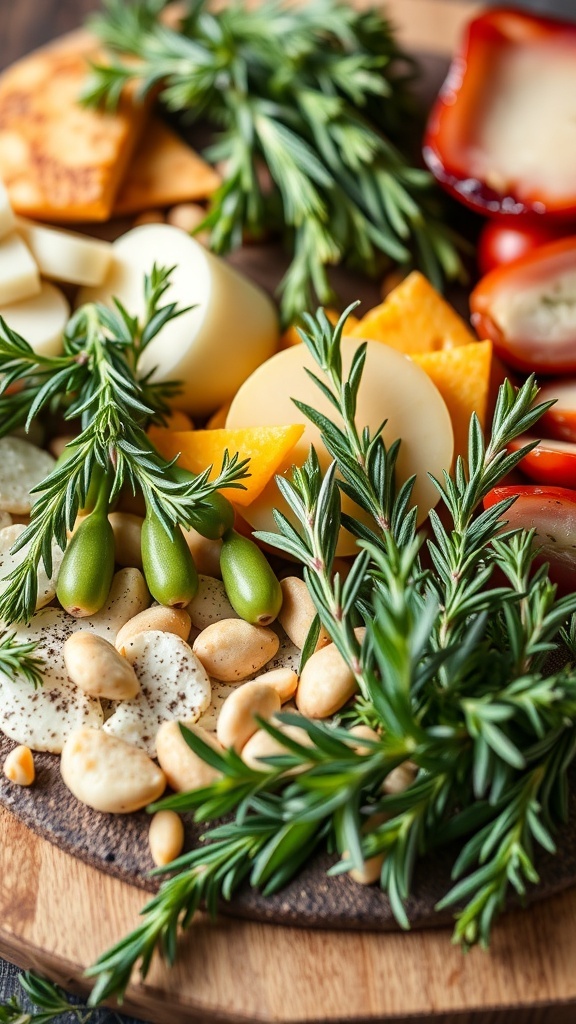Oxtail Recipe
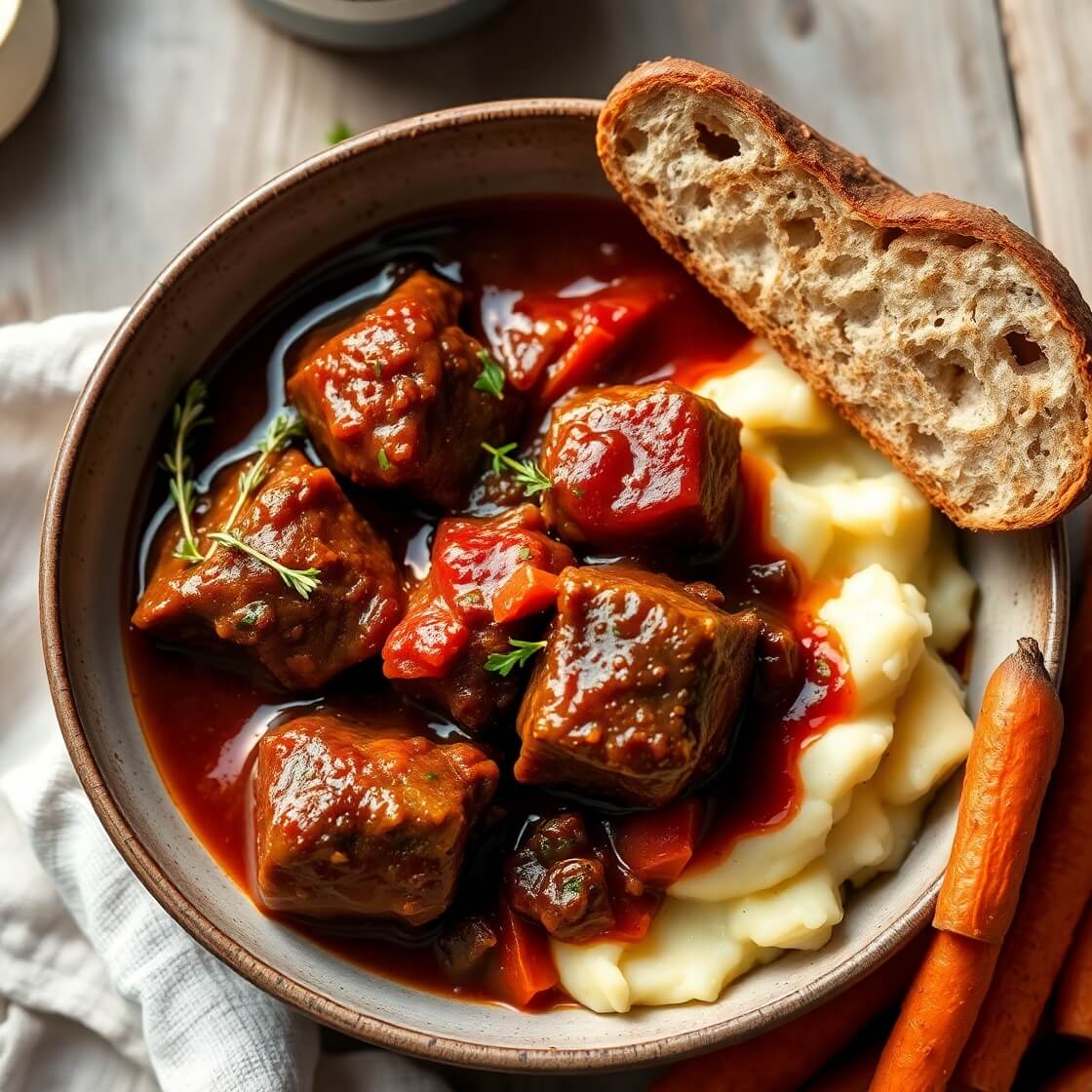
I still remember the first time I cooked oxtail. I was standing in my grandmother’s kitchen, clutching a paper-wrapped bundle from the butcher like it was some sort of mysterious treasure. The cut looked humble—just knobby bones with barely any meat clinging to them. I wasn’t convinced it would turn into anything worth all the fuss.
But the moment those bones hit the pot and began to brown, I realized this was no ordinary stew. The smell that rose—deep, savory, almost smoky—was the kind that fills a home and lingers in your sweater long after dinner. Hours later, when the meat finally surrendered and fell from the bone, the broth had transformed into something rich, velvety, and layered with flavors I didn’t think I was capable of coaxing out of a pot.
When my family sat down at the table that evening, the room went quiet. That’s how I knew. No words, just the sound of spoons scraping bowls and content sighs. My father even dunked his bread into the last drops of sauce, something he usually reserved only for his favorite meals.
Since then, oxtail stew has become my way of turning a chilly, gray day into one of warmth and abundance. It’s the recipe I make when I want to remind myself—and everyone around the table—that the best food often comes from the simplest, most overlooked ingredients.
The Secret Behind Its Flavor
The magic of oxtail is in its bones. Unlike a lean cut of beef, oxtail is threaded with connective tissue, marrow, and fat—all the things that break down slowly during long cooking and transform into pure flavor.
When the tail is seared, those browned bits at the bottom of the pot are like little nuggets of gold. Add in aromatics like onions, carrots, and garlic, and suddenly you’re building layers. Pour in a good stock (beef or chicken both work) along with red wine or stout beer, and you’ve just set the stage for a broth that’s thick enough to coat a spoon and complex enough to taste like it took generations to perfect.
Here’s the part I underestimated the first time: patience is everything. Oxtail simply won’t be rushed. At around the three-hour mark, the meat turns silky and slips off the bone. The marrow melts into the stew, thickening it naturally. What looks like a humble pot of bones becomes a dish that can stand shoulder-to-shoulder with the fanciest short rib or braised lamb shank.
The beauty of this dish isn’t just its depth of flavor—it’s also how versatile it is. Some nights I lean Italian and toss in rosemary and tomato paste. Other times, I go the Caribbean route with scotch bonnet peppers, thyme, and allspice. The bones welcome every spice cabinet adventure.
Ingredients in Context
I don’t want this to feel like one of those stiff ingredient lists you skim past. When I shop for oxtail, I think about each item in terms of what it does for the dish.
- Oxtail – Look for pieces that have a good balance of meat and bone. The larger sections are meatier, while the smaller ones lend richness to the broth. If you can, ask your butcher to cut them evenly.
- Aromatics (onion, carrot, celery, garlic) – These are the backbone of nearly every stew, but here they do double duty. They sweeten the broth and add body once they break down.
- Tomato paste – Don’t skip this. It gives the stew a savory tang and deep color. Cook it a minute or two until it darkens; that’s when it releases its magic.
- Wine or stout – A splash of red wine adds fruitiness, while stout brings a roasted, almost coffee-like richness. Either works; I pick based on what’s open.
- Beef stock (or chicken, in a pinch) – Homemade is best, but a good store-bought version is fine. The oxtail bones will boost it anyway.
- Herbs (thyme, bay leaf, parsley, rosemary) – Fresh herbs make the broth taste alive. I like to tie them into a little bundle with kitchen twine so they’re easy to fish out later.
- Potatoes or beans – These are optional, but I love adding one or the other. Potatoes soak up all that gravy, while beans turn it into something heartier.
- Seasonings (salt, pepper, maybe a pinch of allspice or smoked paprika) – This is where you can really make it your own. Allspice leans Caribbean; smoked paprika pulls it toward Spanish flavors.
The trick is not to overload the pot. Let the oxtail be the star. Everything else is supporting cast.
Step-by-Step Instructions
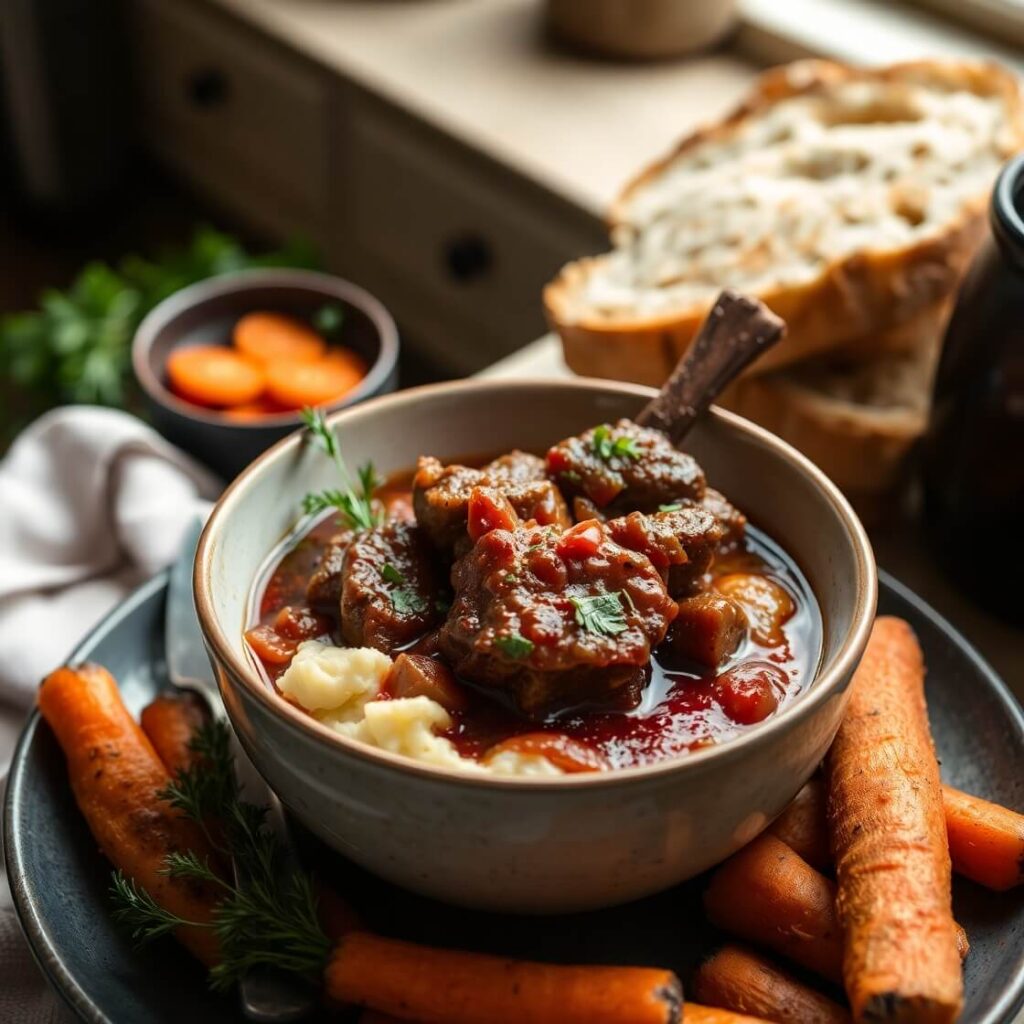
Here’s how I cook it, with the little cues I look for along the way.
Sear the oxtail. Pat it dry first—it makes all the difference. Drop the pieces into a heavy pot with a slick of oil and listen for that sizzle. Don’t rush this step. When the sides are dark brown and crusty, you know you’re building flavor.
Sauté the aromatics. Once the oxtail is out, toss in your onion, carrot, and celery. The smell will immediately soften. Scrape up the browned bits from the bottom as they sweat. Garlic goes in last so it doesn’t burn.
Toast the tomato paste. This is where the stew gets its depth. Push the veggies to the side, add the paste, and stir until it darkens from bright red to brick. That’s your sign it’s ready.
Deglaze with wine or stout. Pour it in and listen to the hiss. Use your spoon to scrape every last bit off the bottom. This step is pure transformation.
Add stock and herbs. Return the oxtail, pour in enough broth to cover, and tuck in your herb bundle. This is where patience enters. Bring it to a simmer, then lower the heat until it’s barely bubbling.
Braise low and slow. Cover partially and let time do its work—about three hours. Every so often, skim off any fat that rises to the surface. The stew will slowly thicken, the meat will loosen, and the broth will turn glossy.
Final touches. When the meat is tender enough to fall from the bone with a fork, taste and adjust seasoning. Sometimes I add a splash of vinegar or lemon juice right at the end to brighten it. If using potatoes or beans, add them during the last 45 minutes so they’re tender but not mushy.
By the time it’s done, your kitchen will smell like a restaurant and a family home rolled into one.
Substitutions & Adaptations
The best part about this recipe is how forgiving it is.
- No oxtail? Try short ribs or beef shank. They have the same bone-and-meat balance, though they’ll never quite give you that marrow richness.
- Gluten-free option – Skip the beer and use wine or stock. The rest is naturally gluten-free.
- For a lighter broth – Swap potatoes for white beans or lentils. They keep the dish hearty without weighing it down.
- Vegetable boost – Add chunks of parsnip, turnip, or rutabaga for a rustic, earthy note.
- Spice variation – If you want Caribbean flavor, use scotch bonnets, thyme, and allspice. For Italian, lean into rosemary, fennel seed, and maybe a touch of balsamic vinegar.
- Pressure cooker adaptation – If you’re short on time, you can absolutely make this in a pressure cooker. It won’t have quite the same slow-simmer romance, but you’ll still get tender meat in about an hour.
The beauty of a stew like this is that it changes with what’s in your pantry. It never feels rigid.
Serving Ideas That Elevate the Stew
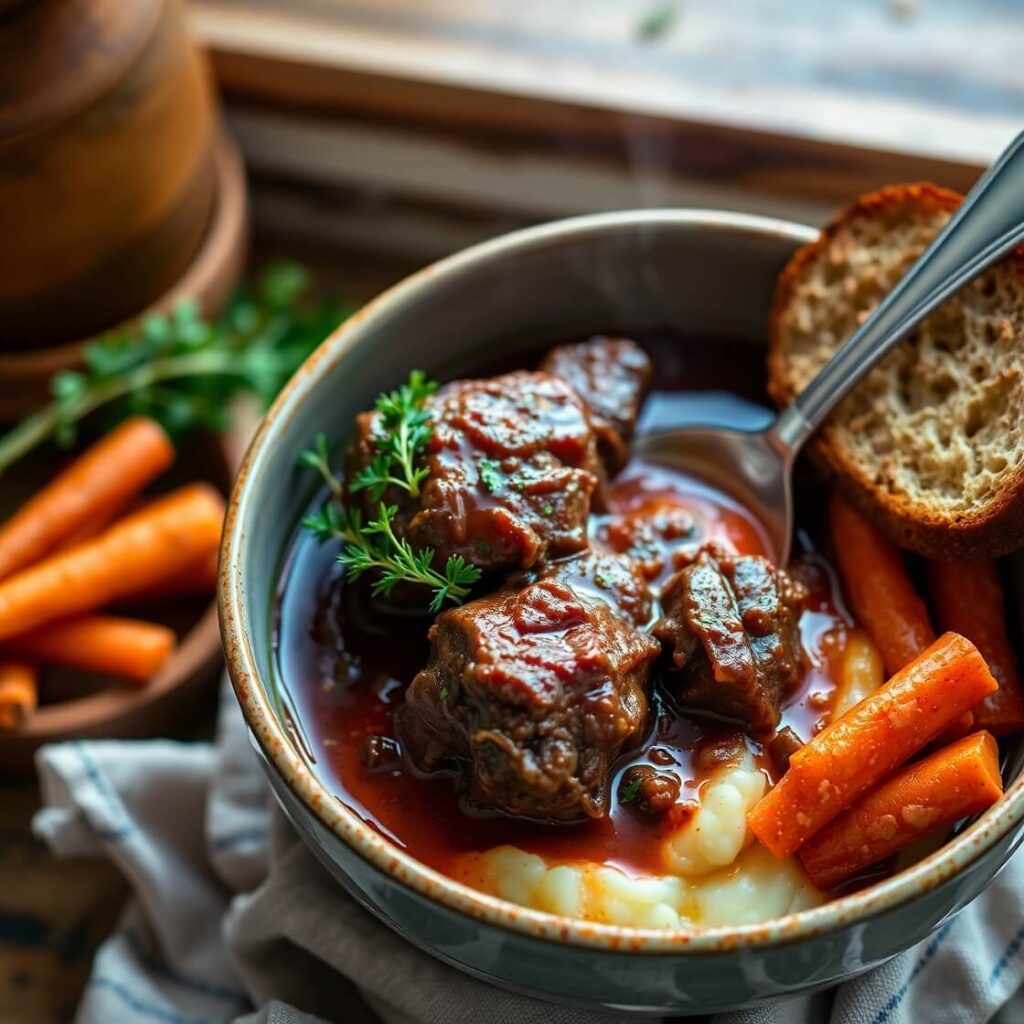
Oxtail stew is one of those dishes that’s satisfying on its own, but pairing it with the right side takes it from comforting to unforgettable.
My family’s favorite is a big basket of crusty bread. Something with a chewy crust and soft interior that can soak up every last spoonful of broth. If I have time, I’ll bake a loaf of no-knead bread the day before—it feels almost ceremonial to crack into it as the stew simmers.
For something heartier, creamy mashed potatoes are a classic partner. The stew ladled over a fluffy mound of potatoes is one of those meals that makes you close your eyes after the first bite. On days when I want a little variety, I’ll swap the potatoes for polenta or even buttered egg noodles.
If you’re leaning toward a Caribbean version, rice and peas or simple steamed white rice are the traditional accompaniments. The rice acts like a sponge, soaking up the rich sauce and balancing the spice.
A bright side salad—peppery arugula with lemon vinaigrette or a simple cucumber and tomato mix—also works wonders, cutting through the richness of the stew.
Pro Notes & Mistakes to Avoid
I’ll be honest: my first attempt at oxtail stew wasn’t perfect. I made a couple of mistakes that taught me lessons I now pass along.
- Don’t skip the sear. The first time, I rushed and just tossed the oxtail into simmering stock. The result was bland and flat. Browning the meat and caramelizing those edges is where the flavor begins.
- Patience really is key. I once tried to serve it after only two hours. The meat was chewy, the broth thin. It needs at least three hours, sometimes closer to four depending on the size of the pieces.
- Avoid overcrowding the pan. If you pile in too many pieces when browning, they’ll steam instead of sear. Work in batches—it’s worth the extra minutes.
- Season in layers. Salt lightly as you go: when searing, when sautéing the vegetables, and again at the end. If you only season at the finish, it won’t taste balanced.
- Skim the fat. Oxtail is fatty, which is part of its beauty, but if you don’t skim the surface during cooking, you’ll end up with a greasy stew.
These little tweaks make all the difference between a stew that’s just fine and one that people remember for months.
Storage and Make-Ahead Tips
Oxtail stew is one of those dishes that actually tastes better the next day. The flavors deepen as they sit, and the broth becomes even more velvety.
- Refrigeration: Let it cool, then store in an airtight container for up to four days. The fat will solidify on top, making it easy to scrape off before reheating.
- Freezing: This stew freezes beautifully. Portion it into containers or freezer bags and store for up to three months. Thaw overnight in the fridge before reheating.
- Reheating: Warm it gently on the stove over low heat. Add a splash of stock or water if it’s too thick.
I sometimes make a double batch just so I can stash half in the freezer. There’s nothing better than pulling it out on a busy weeknight and having a meal that tastes like you cooked all day.
Frequently Asked Questions
Do I need to soak or blanch the oxtail first?
Not necessarily. Some cooks like to blanch briefly to remove impurities, but if you skim during cooking, you’ll get a clear, rich broth without that extra step.
Can I use a slow cooker?
Absolutely. Brown the oxtail and sauté your vegetables on the stove first, then transfer everything to the slow cooker. Cook on low for 8–9 hours or high for 5–6.
What if I don’t want to use alcohol?
No problem. You can substitute extra stock, or for a touch of acidity, add a splash of balsamic vinegar or Worcestershire sauce instead.
How do I know it’s done?
The meat should be fork-tender and pull away from the bone without resistance. The broth will also thicken naturally from the collagen breaking down.
Is oxtail expensive?
It used to be a budget cut, but it’s become more popular. Buying from a local butcher can sometimes save money compared to pre-packaged grocery store portions.

Oxtail Recipe
- Total Time: ~4 hours
- Yield: 4 1x
- Diet: Halal
Description
Slow-braised oxtail is a dish full of rich flavors and comforting textures. With its fall-off-the-bone tenderness and a savory, wine-kissed tomato gravy, this oxtail recipe is the kind of meal that feels like a warm embrace. Perfect for cold evenings or a special Sunday dinner, this dish rewards you with luxurious flavor after a long, gentle simmer. Paired with mashed potatoes or fluffy rice, it turns a rustic cut of meat into something extraordinary. This is more than just a recipe—it’s a tradition, a centerpiece, and a delicious way to gather your loved ones around the table.
Ingredients
- 3 pounds oxtail, trimmed
- Salt and black pepper, to taste
- ½ tsp ground allspice
- ¼ cup all-purpose flour
- 2 tbsp vegetable oil
- 1 large onion, chopped
- 2 carrots, diced
- 2 celery stalks, diced
- 4 cloves garlic, minced
- 2 tbsp tomato paste
- 1 cup crushed tomatoes
- 1½ cups dry red wine
- 2½ cups beef stock
- 1 tsp Worcestershire sauce
- 2 bay leaves
- 4–5 sprigs fresh thyme (or 1 tsp dried)
- 1 tsp smoked paprika
- 1 tsp brown sugar (optional)
- Fresh parsley or thyme, for garnish
Instructions
- Season oxtail generously with salt, pepper, and allspice. Dredge in flour.
- In a Dutch oven, heat oil and brown oxtail pieces on all sides. Remove and set aside.
- Sauté onion, carrot, and celery until softened. Add garlic and tomato paste, cooking until fragrant.
- Deglaze with wine, scraping up browned bits. Simmer for 2 minutes.
- Stir in crushed tomatoes, stock, Worcestershire, herbs, paprika, and sugar. Return oxtail to the pot.
- Cover and simmer on low heat for 3–3.5 hours until meat is tender.
- Uncover and reduce sauce for 15–20 minutes to thicken. Skim excess fat.
- Adjust seasoning, garnish, and serve over mashed potatoes or rice.
Notes
- Make it a day ahead for deeper flavor.
- Skim fat before serving for a cleaner sauce.
- Add a Scotch bonnet for Caribbean heat
- Prep Time: 25 minutes
- Cook Time: 3–3.5 hours
- Category: Dinner
- Method: Braising
- Cuisine: Southern / Caribbean
Nutrition
- Serving Size: 4
- Calories: 620
- Sugar: 4g
- Sodium: 520mg
- Fat: 38g
- Saturated Fat: 16g
- Unsaturated Fat: 18g
- Trans Fat: 0.5g
- Carbohydrates: 22g
- Fiber: 3g
- Protein: 42g
- Cholesterol: 135mg

